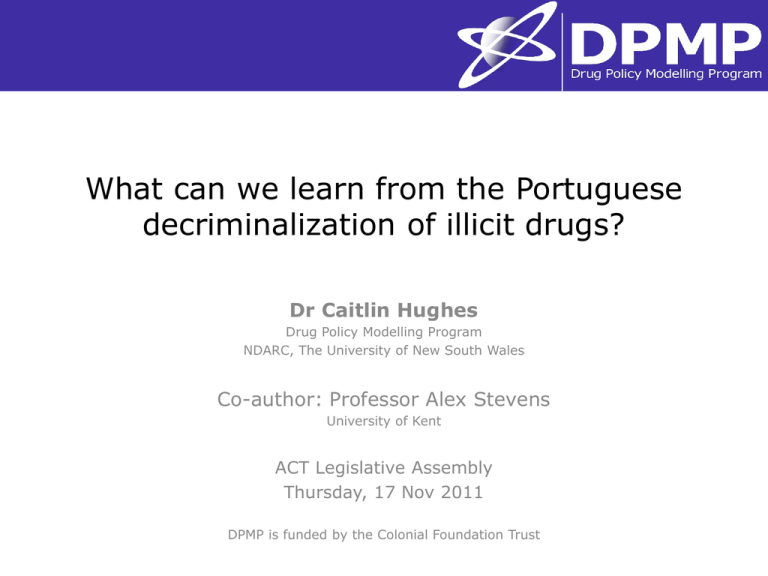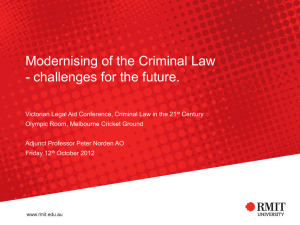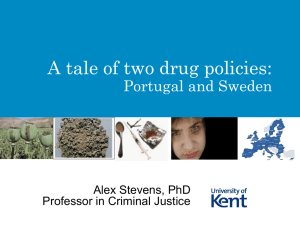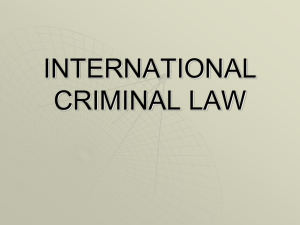here - Families and Friends for Drug Law Reform
advertisement

What can we learn from the Portuguese decriminalization of illicit drugs? Dr Caitlin Hughes Drug Policy Modelling Program NDARC, The University of New South Wales Co-author: Professor Alex Stevens University of Kent ACT Legislative Assembly Thursday, 17 Nov 2011 DPMP is funded by the Colonial Foundation Trust Decriminalisation vs legalisation? • Decriminalisation: removal of sanctions under criminal law, with optional use of alternate sanctions • Legalisation: complete removal of sanctions, making behaviour legal and applying no criminal or administrative penalty Portugal pre reform • Low prevalence of lifetime drug use e.g. In 2001 7.8% of pop aged 15-64 reported ever having used an illicit drug • Increasing rates of problematic drug use, HIV, Hepatitis C • Growing concern over the social exclusion and marginalization of drug users • Perception that criminalization of drug use was worsening the problem The Portuguese reform • Aim: – 1. To remove drug users from the criminal justice system – 2. To discourage and/or treat drug use • • • Law 30/2000: use, possession and acquisition of all illicit drugs, when in small quantities, deemed a public order offence Detected users sanctioned through Commissions for the Dissuasion of Drug Addiction (CDTs) which employ a panel of experts CDTs seek to: – – – • Discuss pattern of drug use and motivations and circumstances of use Refer dependent people to treatment Provide alternate sanctions for non-dependent Introduced as part of a new national drug strategy that expanded treatment, harm reduction etc services Key features of the Portuguese decriminalisation • Applies to all illicit drugs (most other examples of decriminalisation apply to cannabis only) • Legislative reform (not just practice based) • Seeks to provide a therapeutic and social response (not just the removal of criminal sanctions) • Employs drug law reform as a tool to ‘enable’ other drug policy levers: treatment, harm reduction, social inclusion, law enforcement etc Proviso • The lack of a ‘non-reform Portugal’ and the multiplicity of changes make it impossible to attribute any changes in drug use or related harm directly to the fact or form of the Portuguese decriminalization • Yet, we can test the hypotheses aired at the time, that the reform would: 1. Incite interest in drug use 2. Increase drug related harms 3. Reduce the ability of the criminal justice system to function effectively CDTs – numbers processed 8000 Number of processes/decisions 7000 6000 5000 4000 3000 2000 1000 0 2001* 2002 2003 2004 2005 2006 Year Processes Decisions * CDTS were only operational for 6 months of 2001 2007 2008 CDT– rulings made 100% 90% Acquital Proportion of sanctions 80% 70% Suspension 60% Punitive 50% 40% Provisional sanction with treatment Provisional sanction - non dependent 30% 20% 10% 0% 2001* 2002 2003 2004 Year *CDTs were only operational for 6 months of 2001 2005 2006 2007 2008 Did reform incite drug use? Trends in any illicit drug use - general population (aged 15-64) 14 Prevalence of use 12 10 8 6 4 2 0 15-64 15-64 15-64 Lifetime use Recent use Current use 2001 2007 Trends in recent use – by age group 9 8 7 6 5 4 3 2 1 0 15-24 25-34 35-44 2001 2007 45-54 55-64 Trends in recent use – by drug type 4 3.5 3 2.5 2 1.5 1 0.5 0 Marijuana Amphetamines Ecstasy 2001 2007 Heroin Cocaine Trends in school students - recent cannabis use (ESPAD data) 8 7 6 5 4 3 2 1 0 1995 1999 2003 2007 Did reform increase drugrelated harms? Trends in problematic drug users (per 1000 pop aged 15–64 years) – Portugal vs. Italy 10 9 8 7 6 5 4 3 2 1 0 2000 Portugal 2005 2001 2007 Italy 400 80 350 70 300 60 250 50 200 40 150 30 100 20 50 10 0 0 2000 2001 2002 2003 2004 Year Drug-related deaths - INML 2005 2006 2007 Drug-induced deaths (INE) Drug-related deaths (INML) Impacts on drug-induced deaths 2008 Drug induced deaths - INE Drug-related deaths: Deaths that involve a positive post-mortem toxicological test for the presence of any illicit substance (regardless of whether or not the drug caused the death) . Drug-induced deaths: Deaths that physicians determined according to International Classification of Disease protocols to be directly attributable to drug use . Impacts on drug-related HIV and treatment provision 2000 2008 No. users with HIV 907 267 No. users with AIDS 506 108 1998 2008 23,654 38,532 No. in drug treatment Did reform reduce the capacity of the criminal justice system to function effectively? Portugal – Trends in CJS burden-1 16000 Number of offenders arrested 14000 12000 10000 8000 6000 4000 2000 0 1998 1999 Criminal - Trafficker 2000 2001* 2002* 2003* Year Criminal - Trafficker-consumer *From 1 July 2001 consumer offences became administative offences 2004* 2005* 2006* Criminal - Consumer 2007* 2008* Unknown Portugal – Trends in CJS burden-2 16000 Number of offenders arrested 14000 12000 10000 8000 6000 4000 2000 0 1998 1999 2000 Criminal - Trafficker Administrative - Consumer 2001* 2002* 2003* Year 2004* Criminal - Trafficker-consumer Unknown *From 1 July 2001 consumer offences became administative offences 2005* 2006* 2007* Criminal - Consumer 2008* Trends in Spain 300000 Number of offenders detected 250000 200000 150000 100000 50000 0 1998 1999 2000 2001 Criminal - Trafficker 2002 2003 Year 2004 Administrative - Consumer 2005 2006 2007 Impact on prisons and law enforcement ability Impacts on prisons • Between 1999 and 2008 proportion of drug-related offenders in prison decreased from 44% to 21% • Between 2001 and 2007 use of heroin within prison decreased from 27% to 13% • Both findings have been very welcome, due to the historic overcrowding of Portuguese prisons. Impacts on law enforcement ability • Law enforcement officials suggest they have been able to: • • • • refocus their attention on the upper end of the drug market; enhance their international collaborative efforts; and introduce more systematic investigative techniques. Supported by increased quantity of seizures post reform Implications • • • Ten years post reform there is evidence of: – Only small increases in recent drug use – Reductions in the prevalence of problematic drug use – Increased uptake of treatment – Reduction in drug-induced deaths and HIV – Reduced burden on criminal justice system, particularly prison Important to emphasise this is not only a consequence of the law reform But this indicates that even when conducted for all illicit drugs: – Decriminalising use, possession and acquisition will not inevitably lead to a rampant increase in illicit drug use – Nor does it appear to lead automatically to an increase in drug-related harms – It may even assist governments to reduce net harm to the general community Thank You Contact details: Dr Caitlin Hughes P: +61 2 9385 0132 E: caitlin.hughes@unsw.edu.au For more information see: Hughes, C.E. & Stevens, A. (2010) What can we learn from the Portuguese decriminalization of illicit drugs? British Journal of Criminology, 50(6), 999-1022. Hughes, C.E. (2006) Overcoming obstacles to reform? Making and shaping drug policy in contemporary Portugal and Australia, PhD thesis, Department of Criminology, The University of Melbourne.









